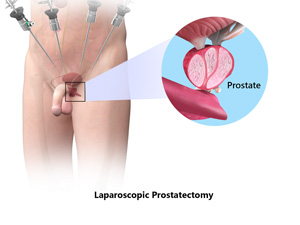
Laparoscopic prostatectomy is a surgical procedure that involves the removal of a part of or complete prostate gland (a gland located below the bladder).
The procedure is indicated for patients with benign prostatic hyperplasia (BPH), a non-cancerous enlargement of the prostate gland. The enlarged gland presses against the urinary bladder and urethra (tube transporting urine from the bladder to the outside) causing urinary problems.
Procedure of Laparoscopic Prostatectomy
The procedure is performed under general anaesthesia. Your surgeon makes 5 small keyhole incisions on your abdomen. A laparoscope (tube with a light and a tiny camera) is inserted to view the enlarged prostate. Surgical instruments are passed through the other incisions to cut and remove the enlarged portion of the prostate gland. A catheter may be inserted at the surgical site to remove fluid build-up. The abdominal incisions are closed with sutures.
Complications of Laparoscopic Prostatectomy
Like all surgical procedures, laparoscopic prostatectomy may be associated with certain complications, which include:
- Injury to surrounding organs
- Infertility
- Urethral stricture (block in the urethra)
- Bowel incontinence (problems controlling bowel movement)
- Urinary incontinence (difficulty controlling urination)
- Retrograde ejaculation (flow of sperm to the urinary bladder instead of through the penis)
Advantages of Laparoscopic Prostatectomy
The advantages of laparoscopic simple prostatectomy when compared to open surgery include:
- Reduced hospital stay
- Faster recovery
- Less post-operative pain
- Smaller incisions and less scarring




